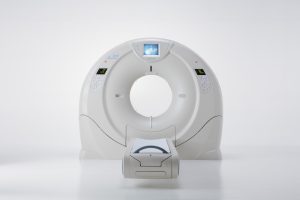News | Press Releases
For Immediate Release Contact marketingcommunications@us.medical.canon
July 17, 2017
Gates Vascular Institute Saves More Than $5.4M Over Five Years by Leveraging Toshiba Medical’s Aquilion ONE Technology
Multiyear Stroke Study Shows Significant Improvements in Cost Savings and Patient Outcomes Realized by Utilizing Premium Area Detector CT Technology

In five years, Kaleida Health’s Stroke Care Center at the Gates Vascular Institute in Buffalo, N.Y., realized more than $5.4 million in cost savings by using Toshiba Medical’s Aquilion ONE CT system.
TUSTIN, Calif., July 17, 2017 – In five years, Kaleida Health’s Stroke Care Center (SCC) at the Gates Vascular Institute in Buffalo, N.Y., realized more than $5.4 million in cost savings by using the AquilionTM ONE CT system from Toshiba Medical, a Canon Group company, to diagnose acute stroke. A multiyear study showed dramatic improvements in patient outcomes across a variety of resource-intensive ICD-9-CM codes, with an up-to-a-full-day reduction in patient length of stay and better discharge dispositions. These results demonstrate that with the right multidisciplinary approach and advanced imaging technology, providers can contain costs while delivering high-quality, effective care that meets the demands of the modern healthcare environment.
Over a five-year span, the SCC, a world-class neurological and stroke care center, quantified the benefits of changing its clinical pathway and leveraging Aquilion ONE technology in stroke diagnosis through a non-controlled study, evaluating imaging procedures, inpatient length of stay and discharge disposition. The study compared inpatient data sets from July to September 2007, prior to the Aquilion ONE installation, with data sets from July to September 2009 (phase one), July to September 2010 (phase two), and July to September 2011 and July to September 2012 (phase three), which utilized the Aquilion ONE and addressed the top three discharging ICD-9-CM codes.
During this time period, the SCC also made significant shifts in other aspects of patient care, further contributing to improved clinical outcomes. Following the relocation of the SCC from Millard Fillmore Gates Circle Hospital to the Gates Vascular Institute, the facility consolidated its vascular services and repositioned its Aquilion ONE CT systems adjacent to areas of high need: the emergency department and the catheterization lab.
“This setup enables us to get patients from the door of the ER to CT imaging, and to the CTA or perfusion exams they may need, within 10 minutes,” said Dr. Nelson Hopkins, SUNY distinguished professor of neurosurgery and radiology, and founder of the Gates Vascular Institute and the Jacobs Institute. “We are also the only stroke care center in the world with all of our vascular disciplines located on the same floor, which has created new synergies between clinicians and significantly improved our work flow. And by having all of our specialists in one building and standardizing all of our imaging equipment to Toshiba Medical systems, we can address virtually any patient need immediately and effectively.”
Highlights of the findings include (full data set on file):
Length-of-Stay Data
| ICD-9-CM Code | 2007 Inpatient Cases – Average Days Length of Stay (w/o Aquilion ONE) | 2009 Inpatient Cases – Average Days Length of Stay (w/ Aquilion ONE) | 2010 Inpatient Cases – Average Days Length of Stay (w/ Aquilion ONE) | 2011 Inpatient Cases – Average Days Length of Stay (w/ Aquilion ONE) | 2012 Inpatient Cases – Average Days Length of Stay (w/ Aquilion ONE) |
| 434.91 – Unspecified Cerebral Artery Occlusion with Cerebral Infarction | 6.03 | 5.58 | 5.24 |
5.23 |
4.98 |
| 435.9 – Unspecified Transient Cerebral Ischemia | 2.69 | 2.55 | 2.51 |
2.7*
|
2.9* |
| 434.11 – Cerebral Embolism with Cerebral Infarction | 7.3 | 7.16 | 6.93 |
6.57 |
5.56 |
Chart Caption: In 2011 and 2012, the SCC saw an even greater reduction in patient length of stay, demonstrating quicker recovery times and ultimately lower healthcare costs.
*Length of stay for ICD-9-CM code 435.9 (Unspecified Transient Cerebral Ischemia) appeared to increase between 2007 and 2011, and between 2007 and 2012. This is in part attributable to correctly identified Unspecified Transient Cerebral Ischemia cases being admitted to the hospital; other, Non-Unspecified Transient Cerebral Ischemia cases would have been discharged as outpatient, thereby increasing the weight of the length of stay for the true Unspecified Transient Cerebral Ischemia cases.
Change in Discharge Disposition
| ICD-9-CM Code | Change in Discharge Disposition from 2007 to 2009 | Change in Discharge Disposition from 2007 to 2010 | Change in Discharge Disposition from 2007 to 2011 | Change in Discharge Disposition from 2007 to 2012 |
| 434.91 – Unspecified Cerebral Artery Occlusion with Cerebral Infarction | 19.5% increase in patients discharging home
|
14.8% increase in patients discharging home
|
55.3% increase in patients discharging home
|
65.3% increase in patients discharging home
|
| 435.9 – Unspecified Transient Cerebral Ischemia** | 76.4% increase in patients discharging to home healthcare | 23.3% increase in patients discharging to home healthcare | 7.1% increase in patients discharging home
|
6.9% increase in patients discharging home
|
| 434.11 – Cerebral Embolism with Cerebral Infarction | 62.8% increase in patients discharging home
|
20% improvement in patients discharging to home
|
73.3% increase in patients discharging home
|
67% increase in patients discharging home
|
Chart Caption: The discharge disposition for patients at the SCC continued to improve in 2011 and 2012 with further use of the Aquilion ONE. For example, patients falling under ICD-9-CM 434.11, the most resource-intensive code, saw a more than 73 percent increase in patients discharged to home in the 2011 data, and a further 67 percent increase in home discharge in the 2012 data.
**2009–2010 data for ICD-9-CM code 435.9 reflects the increase in patients discharging to home healthcare. 2011 saw the first increase in discharge to home for ICD-9-CM code 435.9, thanks in part to the improved patient care facilitated by the Aquilion ONE.
Healthcare Cost Savings
| ICD-9-CM Code | 2009 Quarterly Total Cost Savings | 2010 Quarterly Total Cost Savings | 2011 Quarterly Total Cost Savings | 2012 Quarterly Total Cost Savings |
| 434.91 – Unspecified Cerebral Artery Occlusion with Cerebral Infarction | $118,367 | $197,962 |
$180,567 |
$236,910 |
| 435.9 – Unspecified Transient Cerebral Ischemia | $42,742 | $43,856 | $44,600 | $57,732 |
| 434.11 – Cerebral Embolism with Cerebral Infarction | $29,400 | $86,672 | $99,918 | $212,172 |
| Annualized Savings Total | $762,036 | $1,313,960 | $1,300,340 | $2,027,256 |
Chart Caption: In total, over the past four years, the SCC has achieved more than $5.4 million in annualized savings by using the Aquilion ONE to diagnose stroke.
“Our long-standing partnership with the SCC at the Gates Vascular Institute demonstrates that with advanced imaging technology and the right multidisciplinary approach, providers can significantly improve patient outcomes and reduce overall healthcare costs,” said Tom Szostak, director, Healthcare Economics, Toshiba America Medical Systems, Inc. “Toshiba Medical is proud to be a collaborative partner in helping our customers meet their business needs and the needs of their unique patient populations. Together, we can deliver high-quality care to more patients.”
About Toshiba America Medical Systems, Inc.
Toshiba America Medical Systems, a Canon Group company headquartered in Tustin, Calif., markets, sells, distributes and services radiology and cardiovascular systems, including CT, MR, ultrasound, X-ray and interventional X-ray equipment. For more information, visit Toshiba Medical’s website at www.medical.toshiba.com.
About Toshiba Medical
Toshiba Medical offers a full range of diagnostic medical imaging solutions including Ultrasound, CT, X-Ray, and MR, across the globe. As of December 2016, Toshiba Medical became a member of the Canon Group. In line with our continued Made for Life philosophy, patients are at the heart of everything we do. Our mission is to provide medical professionals with solutions that support their efforts in contributing to the health and wellbeing of patients worldwide so that together our industry-leading solutions deliver an enriched quality of life.



